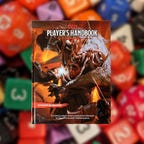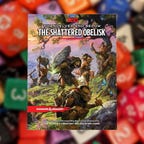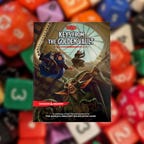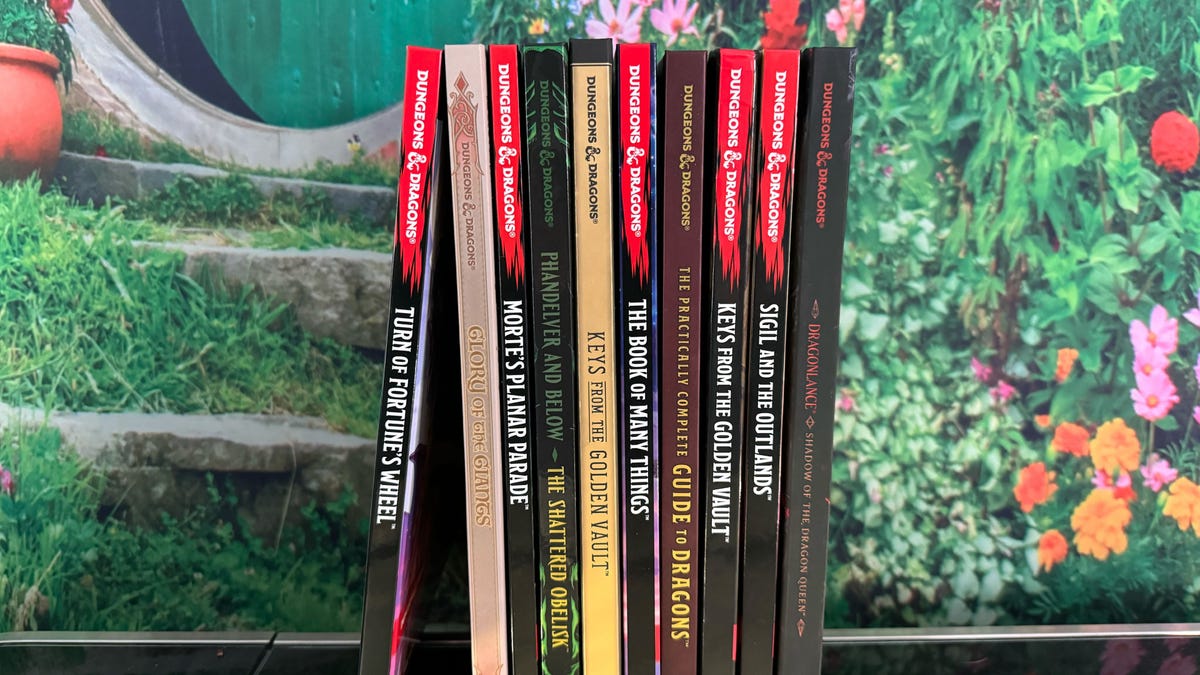
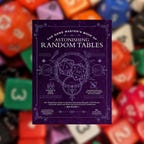
Best Dungeon & Dragons random generator book
The Game Master’s Book of Astonishing Random Tables
View details
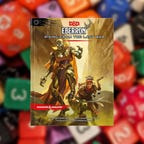
Best alternative to the Forgotten Realms
Eberron: Rising From the Last War
View details
While we live in a digital age, there’s no denying the lure of a good book. Tabletop roleplaying games like Dungeons & Dragons tend to have a lot of books that you can physically hold in your hand as the game is played, more often than not, around a table, with a map, dice and other D&D accessories.
There are plenty of great online tools for Dungeons & Dragons and if you’re trying to play the game with friends in different time zones, digital books can be very helpful, but you miss out on some amazing art, and that very physical feeling of holding knowledge in your hands. Dungeons & Dragons books can be expensive, so it’s worth keeping an eye out for deals, and there are some great third-party books to augment your Wizards of the Coast books too. With a combined total of 54 years of D&D games under our belts, we know a little about what books are best, and we wanted to share that knowledge with you.
This article is primarily about the best Dungeons & Dragons books, but we would be remiss if we didn’t mention the D&D Starter Set. This small box contains everything you need to get started in D&D, including a compelling beginner campaign, some basic rules, dice and pregenerated characters to help you get the feel of how to play. It’s a really good place to start playing, then, when the bug really gets you, these books are the next step.
What’s the best Dungeons & Dragons book?
Whether you’re new to Dungeons & Dragons or an experienced adventurer, the Player’s Handbook — often called the PHB — should be on your gaming shelf. The entire game of D&D can be played with just the PHB, a notepad and pencil, and a set of polyhedral dice. All the other stuff is cool, but those four things are all that’s required.
Best Dungeons & Dragons books
The Player’s Handbook is specifically designed to be a one-stop shop for the basics of Dungeons & Dragons. It doesn’t contain everything, that’s why you buy other books, but it has all of the basic rules, basic spells and how to start a campaign. The most important part of the PHB is the character creation rules, as that’s where the entire game stems from and there is even a section specifically for Game Masters to help them get the party started. If you only buy one book from this list, it should probably be this one.
A random table is a wonderful thing. They’re used to create names, plot devices, treasures and just about anything else by assigning a number to a random thing and having you roll a dice to choose the number. For example, if you roll a 17-18 on a D100 at the ballads and ditties table, you’ll get a song called, “Nate the Naughty and the Trustworthy Orc.” It’s about a farmhand so ugly even the orc won’t eat him.
With the advent of digital random generators, the need for tables in a book may be waning, but for now, this is one of the funniest books to use in the middle of a campaign. With over 300 tables there’s something for everyone.
Many D&D books let you know upfront if they’re built for younger players, folks who have never played before, or a more advanced and slightly darker ride. Phandelver and Below: The Shattered Obelisk is a unique combination, taking what was originally a small story inside a D&D starter set to help new players get the hang of the game and make it spectacularly more complex. If you’ve played Lost Mine of Phandelver before, you’ll find the first 40% of this book familiar and easy to play with any age or skill level, but that story quickly turns to something a great deal scarier and more challenging as your characters grow in level. It’s a great addition to any collection, if only for its ability to be played anywhere by anyone, as well as to offer the kind of darker twist folks who discovered D&D through Stranger Things might be expecting.
Eberron is one of many alternatives to the main universe of Dungeons of Dragons. It’s a world of science and magic, where both of those words are interchangeable. Think steampunk, if the steam was made of magic. There are trains, skyscrapers and sentient robots called the Warforged who are looking to find their place in a world recovering from a giant war. It’s a different take from the low fantasy of Faerun that we’re all accustomed to when playing D&D, but familiar enough to be enjoyable by purists.
While it’s common for DMs to pull stories from published books and add them to a unique campaign, there are few books designed specifically with that idea in mind. Keys from the Golden Vault is a collection of 13 heists built for player groups ranging from level 1 to level 11, each with its own unique story and motivations for whatever alignment your group is currently playing. You certainly can play through this book as though it were a single story, but its higher purpose is to allow you to drop a heist and its associated puzzles into an existing game to offer greater depth to your story.
This book has nearly endless replay value and makes for a genuinely compelling way to either encourage players to work together or gain a little additional experience before being faced with a greater challenge. It’s never far from my table, just in case.
It may surprise you to know that D&D had a multiverse well before the Marvel Cinematic Universe. It’s called Planescape. This new collection of books called Adventures in the Multiverse is everything you need to run a game across the Planes. There’s a book full of new rules and best practices, a book outlining the many creatures you’re likely to run into when you wander too far from home, and a campaign book with a compelling story to help outline this broader set of worlds to explore. There’s also a special DM screen in the box, which includes quick-glance rules and charts to make running the game a little easier. This is a collection for more advanced players and DMs, but it’s the kind of thing you’ll use for years to come and makes just about any game a bit more interesting.
Just in case you want to dip your toe into a tabletop RPG that isn’t Dungeons & Dragons, we recommend the Monster of the Week playbook. MotW is powered by the Apocalypse system that uses two six-sided dice to make all of your tough decisions. This particular book gives you a game that feels like TV shows where a new monster appears each week, hence the name. Archetypes from Buffy, Angel, Supernatural and even Scooby Doo are represented and its serialized play style makes it easy to pick up and put down across different sessions.
There are always a lot of questions to ask when starting a new hobby. Hopefully we can answer some for you here.

